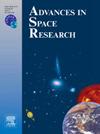Unreleased sunspot records by Hacki in 1671 during the Maunder Minimum
IF 2.8
3区 地球科学
Q2 ASTRONOMY & ASTROPHYSICS
引用次数: 0
Abstract
The Maunder Minimum (1645–1715) was a period characterized by an abnormally low number of sunspots observed on the solar disc. This work focuses on solar activity in 1671, analyzing sunspot number data from a new historical documentary source: five letters exchanged between Hacki and Hevelius, which have been translated from Latin to English. These new records provide an independent confirmation of the sunspot groups observed in 1671, complementing previous works based on observations by other astronomers. Moreover, they highlight some corrections for future versions of the group number database. On the other hand, by compiling all sunspot data for 1671 published so far, we improve our knowledge of the solar activity level in that year. We obtained that the percentage of active days (days when sunspots were observed on the solar disc) was 21.3 %, although with a high uncertainty ranging between 6.3 % and 76.7 % considering days without any record as spotless or active days, respectively. Despite being one of the more active years in the Maunder Minimum, we conclude that the solar activity level in 1671 remains low in comparison to other periods of reduced solar activity, such as the Dalton Minimum. Thus, our study also impacts on the reconstruction of the solar cycle during the Maunder Minimum.
哈基在1671年蒙德极小期未公布的太阳黑子记录
蒙德极小期(1645-1715)是指在太阳圆盘上观测到的太阳黑子数量异常少的时期。这项工作的重点是1671年的太阳活动,分析了来自一个新的历史文献来源的太阳黑子数量数据:哈基和赫维留斯之间的五封书信,这些信件已经从拉丁语翻译成英语。这些新的记录为1671年观测到的太阳黑子群提供了一个独立的证实,补充了以前其他天文学家基于观测结果的工作。此外,他们强调了对未来版本的组号数据库的一些更正。另一方面,通过对1671年迄今公布的所有太阳黑子数据进行汇编,我们提高了对当年太阳活动水平的认识。我们得到了活动日(在太阳圆盘上观测到太阳黑子的日子)的百分比为21.3%,尽管考虑到没有任何记录的日子分别为无黑子日和活动日,不确定性在6.3%和76.7%之间。尽管是蒙德极小期较为活跃的年份之一,但我们得出的结论是,与其他太阳活动减弱的时期(如道尔顿极小期)相比,1671年的太阳活动水平仍然较低。因此,我们的研究对蒙德极小期太阳周期的重建也有一定的影响。
本文章由计算机程序翻译,如有差异,请以英文原文为准。
求助全文
约1分钟内获得全文
求助全文
来源期刊

Advances in Space Research
地学天文-地球科学综合
CiteScore
5.20
自引率
11.50%
发文量
800
审稿时长
5.8 months
期刊介绍:
The COSPAR publication Advances in Space Research (ASR) is an open journal covering all areas of space research including: space studies of the Earth''s surface, meteorology, climate, the Earth-Moon system, planets and small bodies of the solar system, upper atmospheres, ionospheres and magnetospheres of the Earth and planets including reference atmospheres, space plasmas in the solar system, astrophysics from space, materials sciences in space, fundamental physics in space, space debris, space weather, Earth observations of space phenomena, etc.
NB: Please note that manuscripts related to life sciences as related to space are no more accepted for submission to Advances in Space Research. Such manuscripts should now be submitted to the new COSPAR Journal Life Sciences in Space Research (LSSR).
All submissions are reviewed by two scientists in the field. COSPAR is an interdisciplinary scientific organization concerned with the progress of space research on an international scale. Operating under the rules of ICSU, COSPAR ignores political considerations and considers all questions solely from the scientific viewpoint.
 求助内容:
求助内容: 应助结果提醒方式:
应助结果提醒方式:


